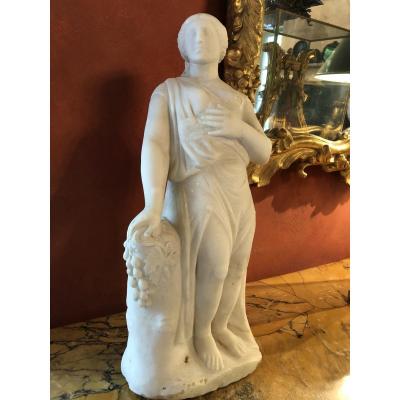Mid-15th century
England, Nottingham sculpture workshops
Dimensions: h. 18 cm, w. 12cm, d. 8 cm
Presented on a painted iron base
Height including the base: 24 cm
This rare crowned head of the Virgin that we are offering belongs to the apogee of English Gothic production of sculpted alabasters and was originally part of the exceptional statue which must have measured approximately 100 cm high of a Virgin with the 'Child sitting or standing.
Her majestic expression, oval face with large forehead, elongated and straight nose, she hints at a half-smile with her thin lips. The Virgin is wearing a delicately sculpted crown, her beautiful, serene face is framed by wavy locks.
To imagine what our sculpture looked like in its entirety, simply compare it with the extremely rare virgins which are kept in some churches in France and England.
The most famous is the Virgin of Westminster Cathedral (91 cm, circa 1450). His crowned head is very close to our sculpture.
The churches of Normandy: Cherbourg, St Martin de Varreville and Teurthéville Haugue also have its exceptional large Virgins and Child of Nottingham.
The vast majority of Nottingham alabasters found today are objects exported to Europe in the 15th century. Most of the works that remained on site in churches and private chapels were destroyed following the Act of Uniformity prohibiting the worship of images published in 1549 and the Reformation of the Church under the reign of Edward XVI.
Thus our head could be a fragment escaped or saved from iconoclasm.
Of all the large virgins produced in Nottingham and remaining in England, none survived the mass destruction caused by the Reformation. Moreover, the only sculpture that was found buried behind the church of All Saints at Broughton-in-Craven in the county of York in 1863 was unfortunately headless….
Alabaster sculpture from England is divided into several categories (large statues (80-100 cm high), altarpiece applique figures and altarpiece panels carved in high relief (40-60 cm high) If the carved altarpieces were produced in series and in large numbers, the independent sculptures are the rarest, his statues were generally placed in wooden niches closed with shutters.
To better understand the rarity of his sculptures, it is important to know that researchers today count around 40 large Virgins, in contrast to two thousand four hundred panels and seventy altarpieces which remain in public and private collections.
Alabaster carving workshops:
Alabaster panels decorated with sculpted religious scenes, produced in the English Midlands at the end of the Middle Ages (between approximately 1350 and 1530), constitute England's major contribution to the field of medieval sculpture. Although a large number of them were destroyed following the Anglican Reformation (from 1534), there remain a number exported legally or sold clandestinely on the Continent. Despite the duration of this period of production, approximately 200 years, the works remain surprisingly homogeneous from a stylistic point of view, which makes them easily identifiable.
Alabaster has not been considered an economical substitute for marble. At the end of the Middle Ages and the beginning of the Renaissance, in fact, the terms "marble" and "alabaster" were used indiscriminately and were often confused.
What brought the two types of stone together was not their geological natures – of course very different – but their dazzling and immaculate whiteness as well as their ability to be polished and to reflect light.
According to several corroborating testimonies, alabaster was even more esteemed than marble.
The main centers of extraction in medieval times were located near Tutbury and Chellaston, not far from Nottingham. This geographical position influenced the installation of numerous sculptors in Nottingham.
Bibliography:
Alabaster sculptures from the Middle Ages: from England to Normandy: Rouen, Departmental Museum of Antiquities, February 12-May 31, 1998 [and] Evreux, Museum of the former bishopric, July-October 1998. Illustrations n° 18 ,19,20
Westminster Cathedral: From Darkness to Light, Patrick Rogers · 2003, p. 37



























 Le Magazine de PROANTIC
Le Magazine de PROANTIC TRÉSORS Magazine
TRÉSORS Magazine Rivista Artiquariato
Rivista Artiquariato
